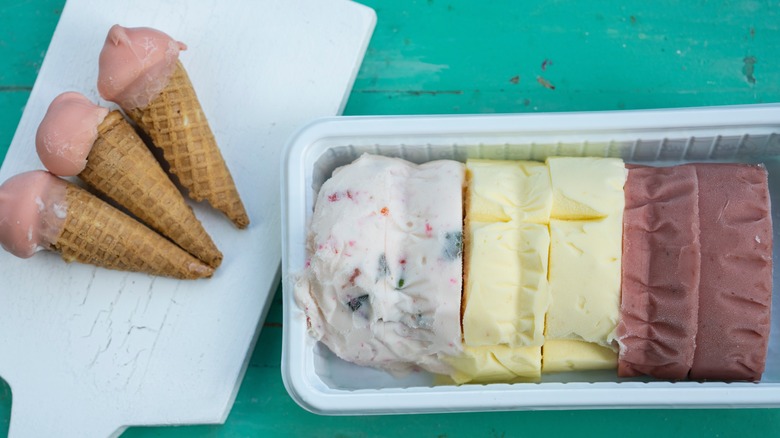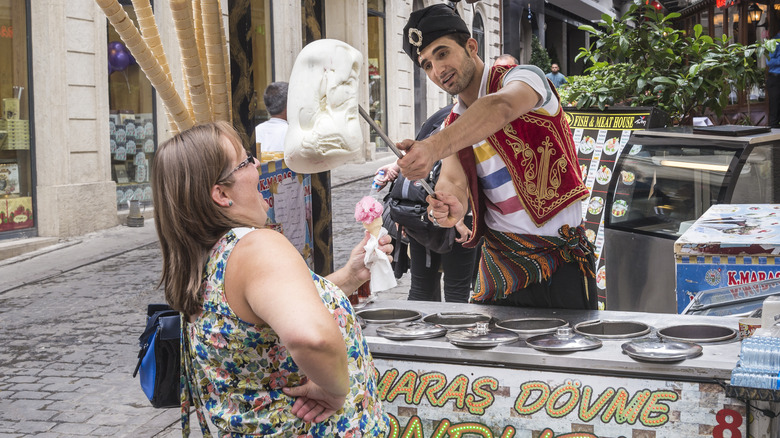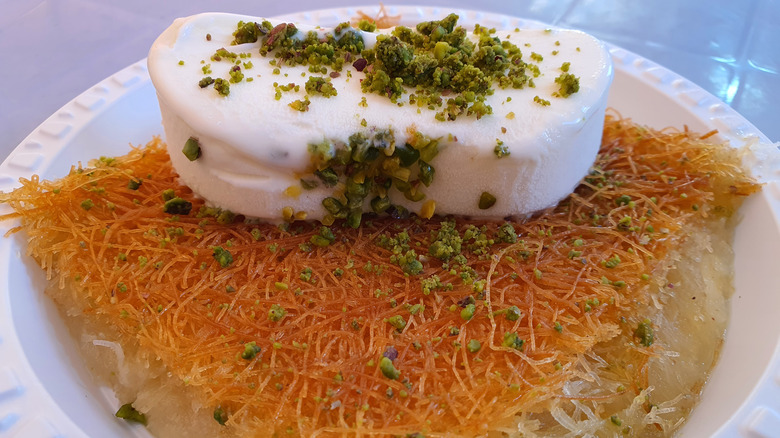Dondurma Is The Turkish Ice Cream That Never Melts
One of many ice creams from around the world, dondurma — also known as Turkish ice cream — draws tourists galore to street carts and markets in Istanbul and across the entire country. Its name comes from the Turkish word for "freezing," but it goes by regional names as well, including Maraş dondurmasi, referring to the area of Kahramanmaras where the ice cream came to life. The production and serving of dondurma by local vendors in traditional attire is quite the experience, with long poles, stretchy showmanship, and playful tricks.
As if that weren't intriguing enough, dondurma also has inherent qualities that are mind-boggling to travelers accustomed to Western-style ice cream. Not only is it made from the starchy pulp of exotic wild orchids –- but it also never melts. Adding to the curiosity is an aromatic mastic sap or pine resin ingredient extracted from relatively obscure mastic trees growing primarily in Chios, Greece, but in Turkey as well. Add that all together, and you get an ice cream like no other, one that lands on lists touting the "world's best ice creams."
The orchids provide an ingredient known as salep, which comes from grinding exclusive orchid bulbs, grown and sold within Turkey, into a powder that's mixed with the mastic sap. Add the other two ingredients, sugar and milk (traditionally goat's milk) for an impressively thick, stretchy, chewy ice cream. In addition to being delicious, the elasticity is perfect for entertaining kids and adults alike.
Showmanship is part of the dondurma experience
In Turkey, asking for an ice cream cone filled with dondurma starts a good-hearted revelry that borders on theatrics while showcasing honed artisan skills. Vendors, who may or may not have made the ice cream themselves, incorporate metal rods into the fun. The rods are reflective of a traditional preparation method in which dondurma experts beat the ice cream with the long rods, mixing and kneading until it reached the desired thick, chewy texture.
When selling ice cream at street markets, the rods become implements for pranking unsuspecting buyers. The sellers typically dress in traditional red embroidered vests and hats from the Kahramanmaraş region, still known as the ice cream capital of Turkey. They dangle and twirl the stretchy dessert, then pull back as the buyer reaches for it, sometimes dropping a huge oversized blob of it atop the cone. Eventually, the buyers end up with a manageable but overflowing cone of the unmelting, tasty treat –– and a really fun memory. This thick delight won't drip even as temperatures soar, and you'll notice a slightly different texture to American-style ice cream — slightly less creamy but with a wonderful chew and stretch.
More ways to enjoy dondurma ice cream
Nibbling dondurma from a cone isn't the only way to enjoy this Turkish specialty. You can also order it in thick slices, especially in Turkish restaurants, often topped with regional garnishes such as pistachios, cinnamon, honey, or other spices. Since the mastic sap tends to retain its evergreen pine taste, purveyors offer alternatives for hesitant tastebuds. It's routinely offered in chocolate and various fruit flavors, and with mixed-in nuts or dried fruits.
Many regional desserts incorporate Turkish ice cream into the presentation, including a national favorite during Ramadan, fried Turkish kadayif. The dondurma comes stuffed into the middle or resting on top. The Turkish semolina halva cake also comes alive when made with dondurma tucked inside the warm, coarse exterior.
It's hard to find dondurma outside Turkey, mostly due to the endangered status of the crucial orchids providing the salep. However, some grocery stores reportedly offer products that simulate the original Maris dondurmasi ice cream. Instead of using the exclusive orchid-powder salep, they substitute available natural thickeners such as guar gum. But don't count on actually finding one of the alternatives locally –– or on it having the unforgettable and inimitable taste and texture of the Turkish national treasure treat. It's still quite rare in the States.



